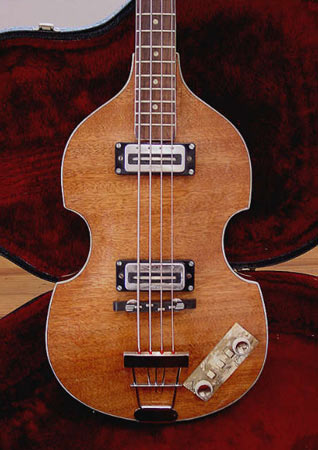
I bought mine a while back, discovered at a local music store. It is unique in being a very light weight and comfortable instrument to play, easily half the weight of a normal solid body guitar, but with a wonderful organic, real instrument 'woody' sound like a real string bass. It is hollow inside and resembles a violin, hence the nickname "violin bass".
Further, it has a very comfortable narrow neck unlike most electric or acoustic basses, perfect for someone like myself with small hands, and can be played like a guitar. Perhaps this is the root of some of McCartney's very melodic bass lines- (but probably more due to the connections inside his brain). When purchased it had already been re-finished many years ago, so I decided to at last remove a rather unflattering cracked solid black coat it had worn, and let the real wood underneath be seen again, seen below after my work...

After removing the old finish and a few layers of thin laminate wood from the top, I put the strings back on to see if their was a change in sound. To my shocking surprise, I discovered that the over-thick layers of wood on the top were structurally important in holding up the bridge, and that the instrument was now unplayable. (The bridge is that horizontal piece just under the lower pickup on which the strings rest.)
This caused an immediate backwards click of my amygdala and a big feeling of "Oh gosh, what have I done...?"
The idea of ruining a collectors item, and a rather valuable instrument was a rather unpleasant scenario.
Fortunately, after about 25 minutes of repeated forward clicking effort (rather than total dispair), the frontal lobes worked out the silver lining. I merely inserted a soundpost inside the body under the bridge in exactly the same way a regular violin has a soundpost to support the bridge.
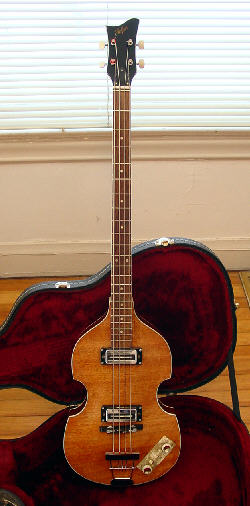
Life is always a challenge and full of unexpected surprises.
The trick is to keep your brain-cool till your amygdala FULLY clicks forward into
frontal lobes TOTAL brain solution. Don't give up the click, no matter how bad things look.
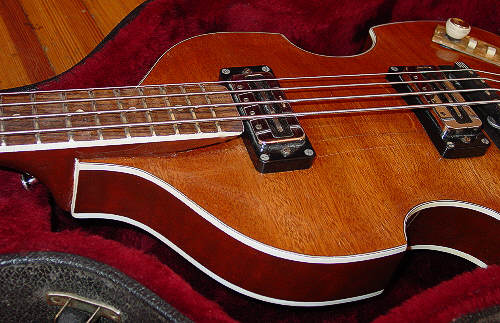
A Few Technical Notes:
The laminate top and back consisted of
VERY thin crossed layers of mahogany with dark glue in between each. Getting a nice entire
piece of wood without glue showing was much more difficult on the front than on the back- which took about
three attempts and going through that many layers of laminate. The grain of the wood on the back
(Unfinished sanded instrument at right) UPDATE A YEAR LATER: In the end, the violin varnish was a
horrible mistake, and I will never use this stuff again. Not recommended unless
you know someone who is an expert with the stuff, and can tell you more than I
know. I'm not even sure it was my user error, but perhaps more related to
unusual qualities of this finish material, which was purchased from a respected
otherwise woodworking store. Either it was total crap, not what it claimed to
be, terrible application instructions on the bottle and salesperson, or
something I haven't identified. It may have been that I applied this material
too thick and could only be applied very thin at any given time. However, I
haven't made this mistake previous, and if it was meant to go on extremely thin,
there was no mention of this to me anywhere, or by anyone. Regardless of this
particular project finish, if done again, I would use lacquer on this type of
wood and instrument- dries within minutes, and very hard and reasonably
resistant to abuse- as used on Martin guitars and fine acoustic instruments.
Lacquer seems to offer every advantage for a fine acoustic instrument over
anything else- save that it has great odor during application, and much care
should be taken for the lungs while using. As for the violin varnish, the
material took a full YEAR to fully dry- up to that point, marks from the cloth
on my pant's leg would be left in the finish after a few minutes of playing,
and/or my fingerprints would show up on the neck. Within a short period after
fully drying twelve months later, and I had doubts that would even ever occur,
the finish began the typical type of stress cracks from shrinking seen in very
old instruments, and this ultimately covered every inch of the instrument
(except for the front of the headstock, which I left alone). I actually don't
look at this wrinkles as undesirable as it gives it a "vintage" appearance, but
I've never had that problem with any other guitar finish I've ever applied.
For those interested in this sort of thing, the old finish was removed rather quickly with a random orbital disc sander with a bit
of paint remover just in the tight curved spots. Paint remover is best kept away from valuable instruments.
An electric sander however was necessary, as the old re-finish was very thick and hard. 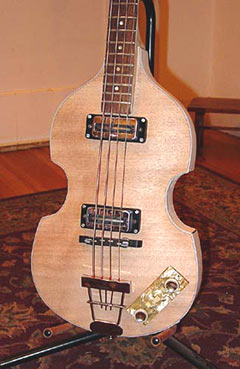 is vertical, and horizontal on the top (front). This process was particularly tricky on this
instrument since both the top and back have ARCHED wood consisting of complex curves, rather
than an easy to sand flat surface.
is vertical, and horizontal on the top (front). This process was particularly tricky on this
instrument since both the top and back have ARCHED wood consisting of complex curves, rather
than an easy to sand flat surface.
The neck and sides are of laminate maple or ash, but the old black finish had seeped
deep into the pores which made
it necessary to tint the finish to hide a few blemishes which were too deep to sand out
on these
parts of the instrument. The end result, however, made this a very wonderful silver lining:
The contrasting sides and neck turned out a very rich color, with its own subtle varied shading, which
further highlights the lighter
top and back.
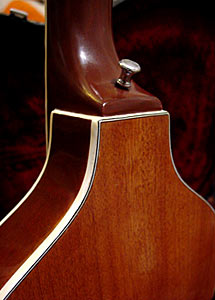 To color the sides and neck, I used earth pigment from the local art store. This is the same
kind of material used to color oil paints, and allowed me to fine tune a color that would
contrast, yet compliment the natural un-colored wood on the top and back. The headstock was
left alone with the original "Hofner" decal, along with all of the original hardware on the rest of the instrument, including
pickups, tuners, etc.
To color the sides and neck, I used earth pigment from the local art store. This is the same
kind of material used to color oil paints, and allowed me to fine tune a color that would
contrast, yet compliment the natural un-colored wood on the top and back. The headstock was
left alone with the original "Hofner" decal, along with all of the original hardware on the rest of the instrument, including
pickups, tuners, etc.
ORIGINAL POST:
I settled on a violin varnish rather than a regular varnish, plastic, or laquer, since the
violin varnish would retain a lot more flexibility than the other finishes. Often musical instruments
show stress cracks in the finish because the wood flexes or expands and contracts over time and temperature
and humidity changes. Violin varnish prevents this to a much greater extent than other
finishes. 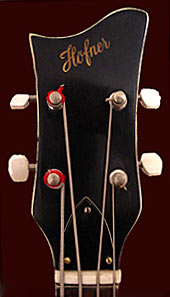 Unfortunately, it
takes about 3 weeks total curing time to get really hard, so I can't play the bass for a while even though the
finish has been applied and "looks dry". The entire refinish job took about five days.
Unfortunately, it
takes about 3 weeks total curing time to get really hard, so I can't play the bass for a while even though the
finish has been applied and "looks dry". The entire refinish job took about five days.
Back to The Amazing Brain Music Adventure
Back to The Library From Another Dimension